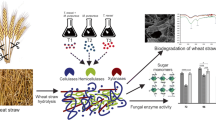Abstract
The effect of lignocellulose degradation in wheat straw, rice straw, and sugarcane bagasse on the accumulation and antioxidant activity of extra- (EPS) and intracellular polysaccharides (IPS) of Inonotus obliquus under submerged fermentation were first evaluated. The wheat straw, rice straw, and sugarcane bagasse increased the EPS accumulation by 91.4, 78.6, and 74.3 % compared with control, respectively. The EPS and IPS extracts from the three lignocellulose media had significantly higher hydroxyl radical- and 2,2-diphenyl-1-picrylhydrazyl radical-scavenging activity than those from the control medium. Of the three materials, wheat straw was the most effective lignocellulose in enhancing the mycelia growth, accumulation and antioxidant activity of I. obliquus polysaccharides (PS). The carbohydrate and protein content, as well as the monosaccharide compositions of the EPS and IPS extracts, were correlated with sugar compositions and dynamic contents during fermentation of individual lignocellulosic materials. The enhanced accumulation of bioactive PS of cultured I. obliquus supplemented with rice straw, wheat straw, and bagasse was evident.






Similar content being viewed by others
References
Zhong JJ, **ao JH (2009) Secondary metabolites from higher fungi: discovery, bioactivity, and bioproduction. Adv Biochem Eng Biot 113:79–150
Zheng W, Miao K, Liu Y, Zhao Y, Zhang M, Pan S, Dai Y (2010) Chemical diversity of biologically active metabolites in the sclerotia of Inonotus obliquus and submerged culture strategies for up-regulating their production. Appl Microbiol Biotechnol 87:1237–1254
Ju HK, Chung HW, Hong SS, Park JH, Lee J, Kwon SW (2010) Effect of steam treatment on soluble phenolic content and antioxidant activity of the Chaga mushroom (Inonotus obliquus). Food Chem 119:619–625
Kim YO, Park HW, Kim JH, Lee JY, Moon SH, Shin CS (2006) Anti-cancer effect and structural characterization of endo-polysaccharide from cultivated mycelia of Inonotus obliquus. Life Sci 79:72–80
Zhang LX, Fan C, Liu SC, Zang ZF, Jiao LL, Zhang LP (2011) Chemical composition and antitumor activity of polysaccharide from Inonotus obliquus. J Med Plants Res 5:1251–1260
Fan LP, Ding SD, Ai LZ, Deng KQ (2012) Antitumor and immunomodulatory activity of water-soluble polysaccharide from Inonotus obliquus. Carbohyd Polym 90:870–874
Kim YO, Han SB, Lee HW, Ahn HJ, Yoon YD, Jung JK, Kim HM, Shin CS (2005) Immunostimulating effect of the endo-polysaccharide produced by submerged culture of Inonotus obliquus. Life Sci 77:2438–2456
Won DP, Lee JS, Kwon DS, Lee KE, Shin WC, Hong EK (2011) Immunostimulating activity by polysaccharides isolated from fruiting body of Inonotus obliquus. Mol Cells 31:165–173
Xu XQ, Wu YD, Chen H (2011) Comparative antioxidative characteristics of polysaccharide-enriched extracts from natural sclerotia and cultured mycelia in submerged fermentation of Inonotus obliquus. Food Chem 127:74–79
Xu XQ, Zhu JW (2011) Enhanced phenolic antioxidants production in submerged cultures of Inonotus obliquus in a ground corn stover medium. Biochem Eng J 58–59:103–109
Zhu LH, Xu XQ (2013) Stimulatory effect of different lignocellulosic materials for phenolic compound production and antioxidant activity from Inonotus obliquus in submerged fermentation. Appl Biochem Biotechnol 169:2138–2152
Chen H, Yan MC, Zhu JW, Xu XQ (2011) Enhancement of exo-polysaccharide production and antioxidant activity in submerged cultures of Inonotus obliquus by lignocellulose decomposition. J Ind Microbiol Biotechnol 38:291–298
**ang YL, Xu XQ, Li J (2012) Chemical properties and antioxidant activity of exopolysaccharides fractions from mycelial culture of Inonotus obliquus in a ground corn stover medium. Food Chem 134:1899–1905
Yan Q, Han L, Jiang ZQ (2004) Removal of protein from the crude astragalus polysaccharides by proteases. Food Sci Technol 6:23–26
Miller G (1959) Use of dinitrosalicylic reagent for the determination of reducing sugar. Anal Chem 31:426–428
Dubois M, Gilles KA, Hamilton J, Rebers PA, Smith F (1956) Colorimetric method for determination of sugar and relative substances. Anal Chem 28:350–366
Chaplin MF, Kennedy JF (1994) Carbohydrate analysis: a practical approach. Oxford University Press, Oxford
Bradford MM (1976) A rapid sensitive method for the quantitation of microgram quantities of protein utilizing the principle of protein-dye binding. Anal Biochem 72:248–254
Singleton VL, Rossi JA (1965) Colorimetry of total phenolics with phosphomolybdic phosphotunstic acid reagents. Am J Enol Vitic 16:144–158
Yang ZY, Tu YY, **a HL (2007) Suppression of free-radicals and protection against H2O2-induced oxidative damage in HPF-1 cell by oxidized phenolic compounds present in black tea. Food Chem 105:1349–1356
Bak JS, Ko JK, Choi IG, Park YC, Seo JH, Kim KH (2009) Fungal pretreatment of lignocellulose by Phanerochaete chrysosporium to produce ethanol from rice straw. Biotechnol Bioeng 104:471–482
Sun FH, Li J, Yuan YX, Yan ZY, Liu XF (2011) Effect of biological pretreatment with Trametes hirsuta yj9 on enzymatic hydrolysis of corn stover. Int Biodeterior Biodegradation 65:931–938
Sun RC, Lawther JM, Banks WB (1996) Fractional and structural characterization of wheat straw hemicelluloses. Carbohyd Polym 29:325–331
Sun RC, Tomkinson J, Ma PL, Liang SF (2000) Comparative study of hemicelluloses from rice straw by alkali and hydrogen peroxide treatments. Carbohyd Polym 42:111–122
Xu F, Sun JX, Liu CF, Sun RC (2006) Comparative study of alkali- and acidic organic solvent-soluble hemicellulosic polysaccharides from sugarcane bagasse. Carbohyd Res 341:253–261
Shih IL, Tsai KL, Hsieh C (2007) Effects of culture conditions on the mycelial growth and bioactive metabolite production in submerged culture of Cordyceps militaris. Biochem Eng J 33:193–201
**ao JH, **ao DM, **ong Q, Liang ZQ, Zhong JJ (2010) Nutritional requirements for the hyperproduction of bioactive exopolysaccharides by submerged fermentation of the edible medicinal fungus Cordyceps taii. Biochem Eng J 49:241–249
Chen H, Zhang M, Qu Z, **e B (2008) Antioxidant activities of different fractions of polysaccharide conjugates from green tea (Camellia sinensis). Food Chem 106:559–563
Acknowledgments
This research was supported by the research grant from the Science and Technology Department of Zhejiang Province, China (2012C23075).
Author information
Authors and Affiliations
Corresponding author
Rights and permissions
About this article
Cite this article
Xu, X., Hu, Y. & Quan, L. Production of bioactive polysaccharides by Inonotus obliquus under submerged fermentation supplemented with lignocellulosic biomass and their antioxidant activity. Bioprocess Biosyst Eng 37, 2483–2492 (2014). https://doi.org/10.1007/s00449-014-1226-1
Received:
Accepted:
Published:
Issue Date:
DOI: https://doi.org/10.1007/s00449-014-1226-1




